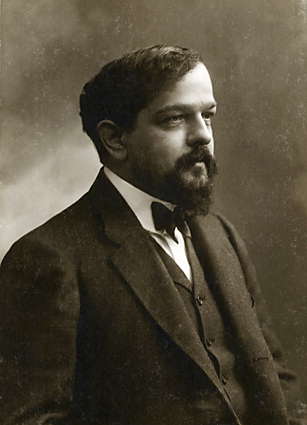

Claude Debussy
The music of French composer Claude Debussy (1862-1918) coincided with the Impressionist movement in art. Certain similarities between that art and Debussy’s style resulted in his music being dubbed “impressionist.” Although Debussy rejected that label, he is today regarded as the foremost Impressionist composer.
Personal Data
Dates: 1862-1918
Born: Saint-Germain-en-Laye, France
Residence: Paris
Debussy Timeline
Claude Debussy was born on August 22, 1862 in St. Germain-en-Laye on the outskirts of Paris. His parents ran a china shop Later, his father later a traveling salesman and clerk while his mother worked as a seamstress. Caught up in the revolutionary sentiments of the time, his father was imprisoned for revolutionary activities in 1871.
Debussy studied piano with Mme Mauté, the mother-in-law of the French symbolist poet Paul Verlaine. In 1872, Debussy’s prodigious abilities on the piano earned him entry into the Paris Conservatory. He developed into a serious virtuoso performer but gave up hopes of a performing career in 1879 when he failed to advance in the piano examination. Then he entered the composition class of Ernest Guiraud and won first place in the prestigious competition known as Prix de Rome in 1883 with his cantata L’enfant prodigue. The prize required him to take up temporary residence in Italy. He stayed in Italy, unhappily, for the two-year minimum period required and then returned to Paris where he remained for rest of his life.
He lived in poor circumstances after his return to France. His admiration of Richard Wagner, in particular the opera Tristan and Isolde, led him to visit Bayreuth. Despite his admiration of Wagner, Debussy took a different path with his music. Indeed, many French composers of the time were searching for new direction contrary to the heavy Germanic influence of Wagner. In a famous quote, Debussy remarked that Wagner was “a beautiful sunset that was mistaken for a dawn.”
He also became close friends with Ernest Chausson, a noted composer of French art songs. He was engaged in 1894 to the singer Thérèse Roger, but the engagement was broken off in a way that cost Debussy his friendship with Chausson. In 1899, he married Rosalie Texler. After the couple separated, Debussy married Emma Bardac in 1908.
He gained public attention in 1893 with a performance of La damoiselle élue, a work for orchestra and female chorus. His first major success came with the premier in 1894 of the orchestral work Prelude a l’apres-midi d’un faune (Prelude to the Afternoon of a Faun), which remains one of Debussy’s most frequently performed works.
Debussy had one child, a daughter born in 1905. The composer died in 1918 at the age of 55 after a long battle with cancer.
Air de Lia from L'enfant prodigue
Debussy won the Prix de Rome in 1883 with L’enfant prodigue. In this aria, which parallels the biblical parable, Lia sings a lament for her absent son, who has gone in search of earthly pleasures.
The complete work has eight movements and ends with the joyful reunion of mother and son.
Suite Bergamasque
If you have heard any of Debussy’s music, you probably know Clair de Lune, one of four movements in his Suite Bergamasque. There are four movements in the suite:
- Prélude
- Menuet
- Clair de Lune
- Passapied
He began writing this suite in 1890, but did not finish it until 15 years later.
A bergamasque is a rustic dance from the northern Italian city of Bergamo.
The work was inspired by the poem Clair de lune by Paul Verlaine, which begins:
Your soul is a chosen landscape
On which masks and Bergamasques cast enchantment as they go,
Playing the lute, and dancing, and all but
Sad beneath their fantasy-disguises.
(You must be logged into the Circle of Scholars to view the rest of this page.)
